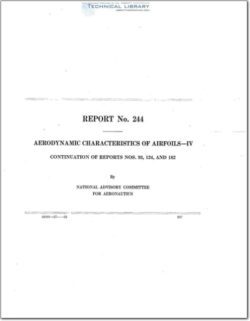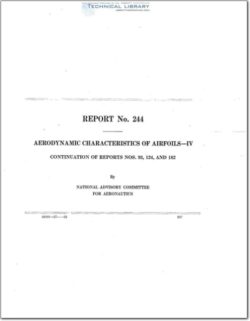naca-report-244

- Version
- 395 Downloads
- 3.28 MB File Size
- 1 File Count
- April 21, 2016 Create Date
- April 21, 2016 Last Updated
National Advisory Committee for Aeronautics, Report - Aerodynamic Characteristics of Airfoils - IV

This collection of data on airfoils has been made from the published reports of a number
of the leading aerodynamic laboratories of this country and Europe.1 The information which
was originally expressed according to the different customs of the several laboratories is here
presented in a uniform series of charts and tables suitable for the use of designing engineers and
for purposes of general reference.
It is a well—known fact that the results obtained in difierent laboratories. because of their
individual methods of testing. are not strictly comparable even if proper scale corrections for
size of model and speed of test are supplied. It is, therefore, unwise to compare too closely
the coefficients of two wing sections tested in difiercnt laboratories. Tests of different wing
sections from the same source, however, may be relied on to give true relative values.
The series of airfoils designated N. A. C. :L—V‘Il to X. A. C. ArVIQT (Reference Nos. 506
to 532) were tested in the variable density wind tunnel of the National Advisory Committee
for Aeronautics at a pressure of approximately 20 atmospheres.
The absolute system of coefficients has been used, since it is thought by the National Advisory
Committee for Aeronautics that this system is the one most suited for international use and
yet it is one from which a desired transformation can be easily made. For this purpose a set
of transformation constants is given.
Each airfoil section is given a reference number, and the test data are presented in the
form of curves from which the coefficients can be read with suficient accuracy for designing
purposes. The dimensions of the profile of each section are given at- various stations along the
chord in per cent of the chord. the latter also serving as the datum line. When two sets of
ordinates are necessary, on account of taper in chord or ordinate, those for the maximum section
(at center of span) are given on the individual characteristic sheets, while those for the tip
(dotted) section are given in separate tables, page 226. Where the ratio of ordinate to chord
remains constant the one set of ordinates applies to both center and tip section. The shape
of the section is also shown with reasonable accuracy to enable one to more clearly visualize
the section under consideration, together with its characteristics.
| File | Action |
|---|---|
| naca-report-244 Aerodynamic Characteristics of Airfoils - IV.pdf | Download |
Comment On This Post